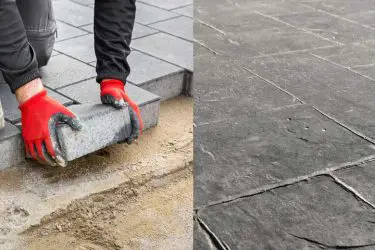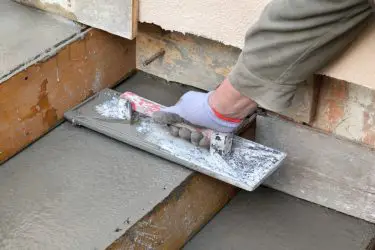Colored concrete is all the rage nowadays. Whether you’ve installed it in your patio, basement floor, driveway, walkways, or garden walls, colored concrete will amaze you in terms of durability and low maintenance. Aesthetics, however, might be doubtful because concrete tends to turn white.
Concrete turns white because of efflorescence. Water from rain or dew soaks into the concrete, dissolving some of the internal salts. As the water rises back to the surface, it takes the salt with it. After the water evaporates, the salt precipitates on the surface, giving the concrete a white look.
Luckily, you can remove these deposits to bring your concrete slab back to its original condition. But first, let’s take a closer look at the chemistry behind efflorescence.

Table of Contents
How and Why Does Efflorescence Happen?
The most common salt behind efflorescence is calcium hydroxide, commonly known as lime.
It’s almost impossible to pin down the source of lime in concrete because it can be found in the sand, water, or gravel used to make concrete. And it can even arise as a natural byproduct of the hydration process of portland cement.
So, it’s pretty much inevitable for any concrete to turn white at some point.
But as long as the salt is buried deep inside the concrete, efflorescence cannot exist. The only thing that can carry these salts to the surface is moisture.
Any source of moisture may induce efflorescence, ranging from deliberate splashing to rainwater. The water will dissolve all the concrete’s internal salts as it seeps through the microscopic pores.
Then, when the water rises back to the surface to evaporate, the salt precipitates on the surface and interacts with the air, producing solid deposits that may be challenging to remove.
Can Efflorescence Happen Without External Moisture?
There are two types of concrete efflorescence: primary and secondary.
The secondary type is the one I explained earlier — it doesn’t happen unless the concrete suffers from water exposure.
On the other hand, primary efflorescence can occur soon after a slab is poured, even in the absence of external moisture. But how does this happen?
As you probably know, water is essential for mixing concrete. But if there’s too much water in the mixture, it’ll gradually flow to the surface within a few weeks after the concrete hardens.
And again, it’ll carry the salt to the surface to precipitate the same white deposits.
Is Efflorescence a Sign of Concrete Failure?
No, efflorescence doesn’t have anything to do with the structural integrity of the concrete. As I said earlier, primary efflorescence can happen in freshly poured concrete, even in the absence of cracking, crumbling, or any other signs of degradation.
However, it’s important to note that the presence of severe efflorescence may indicate moisture levels sufficient to support mold, which might cause some health issues depending on the type of grown mold.
Besides, if you notice efflorescence in concrete ceilings, you must track down the underlying moisture source to avoid future cracking and potential collapse.
Does Efflorescence Increase in Winter?
Both primary and secondary efflorescence is more likely to occur in cool, humid weather.
Cool weather slows down the evaporation process, giving salts more than enough time to rise to the surface and sediment.
On the other hand, dry climates suck out most of the water shortly after it soaks in concrete, preventing the salt from making it to the surface.
How Do You Remove White Residue From Concrete?
In some cases, you could simply just brush the salt residue off. In other cases, it has become more of a white stain which might require some more work to remove.
The easiest way of removing white stains caused by efflorescence from concrete is to apply a special efflorescence remover, like the popular Eco-Etch Pro Concrete Etcher & Cleaner. Let it sit for 10 minutes, then scrub with a hard bristle brush. If the salt has crystallized and hardened, you will need mechanical equipment.
But there are other ways to remove efflorescence as well. Here are som more options:
Let Nature Take Its Course
If the white deposits don’t seem to bother you that much, it’s better to leave them to wear down on their own. In driveways and patios, foot traffic will gradually remove the salt deposits and restore the original concrete color.
Scrub and Wash It Down
If the salt deposits aren’t too hard, brush them off the concrete surface with a broom and then wash down the area with plain water. I don’t recommend using any detergents to avoid the possibility of forming any new deposits.
If the salts have already formed stubborn deposits, you can scrub them with water right away. But keep in mind that the water will soak the salts back into the concrete, meaning that efflorescence may reappear within a few days.
So whenever you spot any white patches on your concrete slabs, it’s better to act fast if you want to use nothing but water and elbow grease.
Pressure Washing and Sandblasting
Pressure washing and sandblasting can effectively remove stubborn deposits if hand scrubbing doesn’t seem to cut it.
You should, however, keep the washer at the lowest pressure setting since high pressure can widen the concrete’s pores, making it easier for water to seep inside, dissolve more salts, and form new efflorescence.
Washing With Acids
Mild acids, such as vinegar and citric acids, can break down salt crystals into tiny particles that you can wash down with water.
If the crystals are more on the stubborn side, hydrochloric acid (HCL) will be your best bet.
However, you should always dilute HCL before applying it to concrete since it’s way too corrosive at full concentration.
You should also wear gloves and a mask to protect yourself against possible health hazards.

If you don’t want to hassle with HCL, consider using the commercial cleaners specially formulated to remove efflorescence. Eco-Etch Pro Concrete Etcher & Cleaner is one of the most famous products in that category.
After removing all the deposits with acid, sprinkle some baking soda on the surface to neutralize any acid remnants, thereby avoiding any possible damage to plants and animals.
Wrap it up with a final wash to remove all the remaining bits of baking soda.
Can You Prevent Concrete Efflorescence?
You can apply a silicate-based concrete sealer to the surface to create a waterproof barrier and prevent the internal salts from reaching the surface.
Here’s what the sealing process usually looks like:
- Remove all dirt, grease, oil, and dust off the concrete.
- Remove any existing sealer.
- Etch the concrete with a suitable acid to make way for the new sealant.
- Apply the first layer of sealant and give it a couple of hours to dry completely.
- Apply a second coat in the opposite direction.
The process may look fairly simple, but I wouldn’t recommend doing it yourself. It’s better to hire a contractor who knows the proper way to handle all the involved chemicals.
Read more: How to Seal Concrete in 7 Easy Steps
Better yet, you may call the contractor who installed the concrete slab and ask if they offer a maintenance package that includes applying sealants.
If you think you have what it takes to do it yourself, keep the following tips in mind before starting:
- If your concrete is still fresh, you should wait at least 30 days to allow it to cure completely before adding the sealer to guarantee optimal results.
- Most sealers require the air temperature to be 50°F (10°C) or more at the time of application and at least 24 hours after.
- Avoid walking or driving over the new sealant for at least three days.
Final Thoughts
To sum up, concrete may turn white upon exposure to moisture. The water will dissolve the internal salts and carry them to the surface, where they’ll precipitate white crystals after the water evaporates.
If possible, try to keep any source of moisture away from the concrete surface. For example, you can point your garden sprinklers away from the driveway or garden walls. But of course, such efforts will be futile if it often rains where you live.
The most effective way to prevent efflorescence is by applying a silicate-based concrete sealer. Remember to follow the manufacturer’s recommendation to ensure optimal results.



